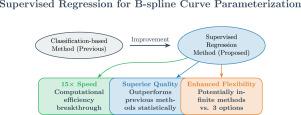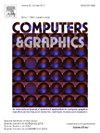A parameterization method for B-spline curve interpolation via supervised regression
IF 2.8
4区 计算机科学
Q2 COMPUTER SCIENCE, SOFTWARE ENGINEERING
引用次数: 0
Abstract
Parameterization plays a crucial role in the quality of B-spline curve interpolation, but automatically selecting an appropriate method for diverse data distributions remains challenging. A recent classification-based hybrid parameterization approach addresses this issue, statistically outperforming alternative methods, but it comes with relatively high computational costs. In this work, an automatic parameterization method via supervised regression is proposed for B-spline curve interpolation. A regressor is first trained on a dataset of randomly generated data point sequences (each of length four), with optimal parameters from those given by classical methods used as labels. The regressor then estimates the optimal local parameters for each set of four consecutive data points based on their local geometric distribution. Global parameters that closely match the local ones are computed through a merging process. Since local parameters are directly generated by the regressor, the proposed method is more efficient than the classification-based hybrid approach. Additionally, since regressors are inherently more flexible than classifiers, the proposed regression-based method is compatible with any existing or new parameterization method — rather than being limited to just the three representative methods used in the classification-based approach — and is capable of producing better results. Experimental results demonstrate that the proposed method efficiently produces superior interpolation curves compared to existing techniques, even outperforming the previous classification-based approach with an idealized theoretical classifier.

基于监督回归的b样条曲线插值参数化方法
参数化对b样条曲线插值的质量起着至关重要的作用,但自动选择适合不同数据分布的方法仍然是一个挑战。最近一种基于分类的混合参数化方法解决了这个问题,在统计上优于其他方法,但它的计算成本相对较高。本文提出了一种基于监督回归的b样条曲线自动参数化插值方法。首先在随机生成的数据点序列(每个长度为4)的数据集上训练回归器,并使用经典方法给出的最优参数作为标签。然后,回归器根据每组四个连续数据点的局部几何分布估计最优局部参数。通过合并过程计算与局部参数密切匹配的全局参数。由于局部参数是由回归量直接生成的,因此该方法比基于分类的混合方法效率更高。此外,由于回归器本质上比分类器更灵活,因此所提出的基于回归的方法与任何现有的或新的参数化方法兼容——而不仅仅局限于基于分类的方法中使用的三种代表性方法——并且能够产生更好的结果。实验结果表明,与现有技术相比,该方法可以有效地产生更好的插值曲线,甚至优于先前基于分类的方法和理想的理论分类器。
本文章由计算机程序翻译,如有差异,请以英文原文为准。
求助全文
约1分钟内获得全文
求助全文
来源期刊

Computers & Graphics-Uk
工程技术-计算机:软件工程
CiteScore
5.30
自引率
12.00%
发文量
173
审稿时长
38 days
期刊介绍:
Computers & Graphics is dedicated to disseminate information on research and applications of computer graphics (CG) techniques. The journal encourages articles on:
1. Research and applications of interactive computer graphics. We are particularly interested in novel interaction techniques and applications of CG to problem domains.
2. State-of-the-art papers on late-breaking, cutting-edge research on CG.
3. Information on innovative uses of graphics principles and technologies.
4. Tutorial papers on both teaching CG principles and innovative uses of CG in education.
 求助内容:
求助内容: 应助结果提醒方式:
应助结果提醒方式:


